Abstract
STUDY OBJECTIVE: To determine the validity of a self administered physical activity questionnaire to be used as part of a screening device for postmenopausal osteopaenia (with additional questions on medical history and calcium intake). DESIGN: A questionnaire was posted to 86 perimenopausal women to enquire about weekly hours spent in non-sedentary activity at work, in the household, and during leisure hours. Subjects who returned the questionnaire were visited at home and asked to complete a four day activity diary and subsequently to undertake a submaximal estimate of VO2 MAX, carried out using a treadmill ergometer. They were interviewed to clarify questionnaire and diary entries. Questionnaire validity was assessed in comparison with the diary estimates of hours of activity and with VO2 MAX. PARTICIPANTS: A total of 86 perimenopausal women aged 43-54 years were randomly selected from a GP list in Hammersmith, London. Thirty five women (41%) returned the questionnaire. They were visited at home, given the diary to complete, and invited to attend the physiology laboratory for VO2 MAX measurements. Twenty six of the 35 (74%) completed the study and were included in the final analysis. MAIN RESULTS: Women spent an average of 51 hours per week in non-sedentary activities. Questionnaire and diary yielded similar results (51.05 versus 51.30 h/wk), and there was a good correlation between diary and questionnaire estimates of total weekly hours of non-sedentary activity (r = 0.45, p < 0.05). Other significant correlations were for standing (r = 0.69, p < 0.01), leisure activities (r = 0.66, p < 0.01), and for light household activities (r = 0.42, p < 0.05). Correlations were better for employed than non-employed subjects. In relation to the diary, the questionnaire correctly classified 60% into the top or bottom half of the distribution activity. Sensitivity and specificity of the questionnaire were both equal to 61.5%. CONCLUSIONS: The questionnaire is useful for classifying subjects according to their level of activity, especially when administered in conjunction with an interview. The four day diary provided a useful reference measure and a focus for discussing activity patterns during an interview related to the questionnaire responses.
Full text
PDF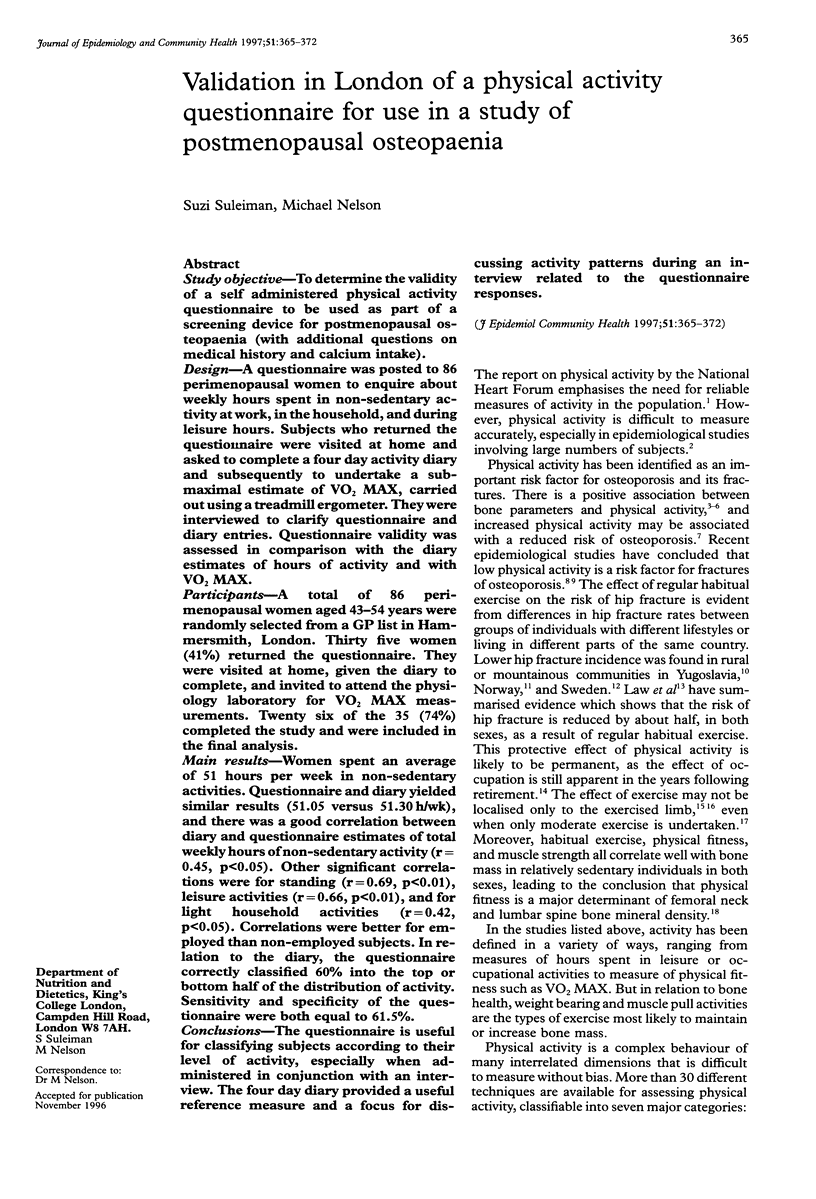
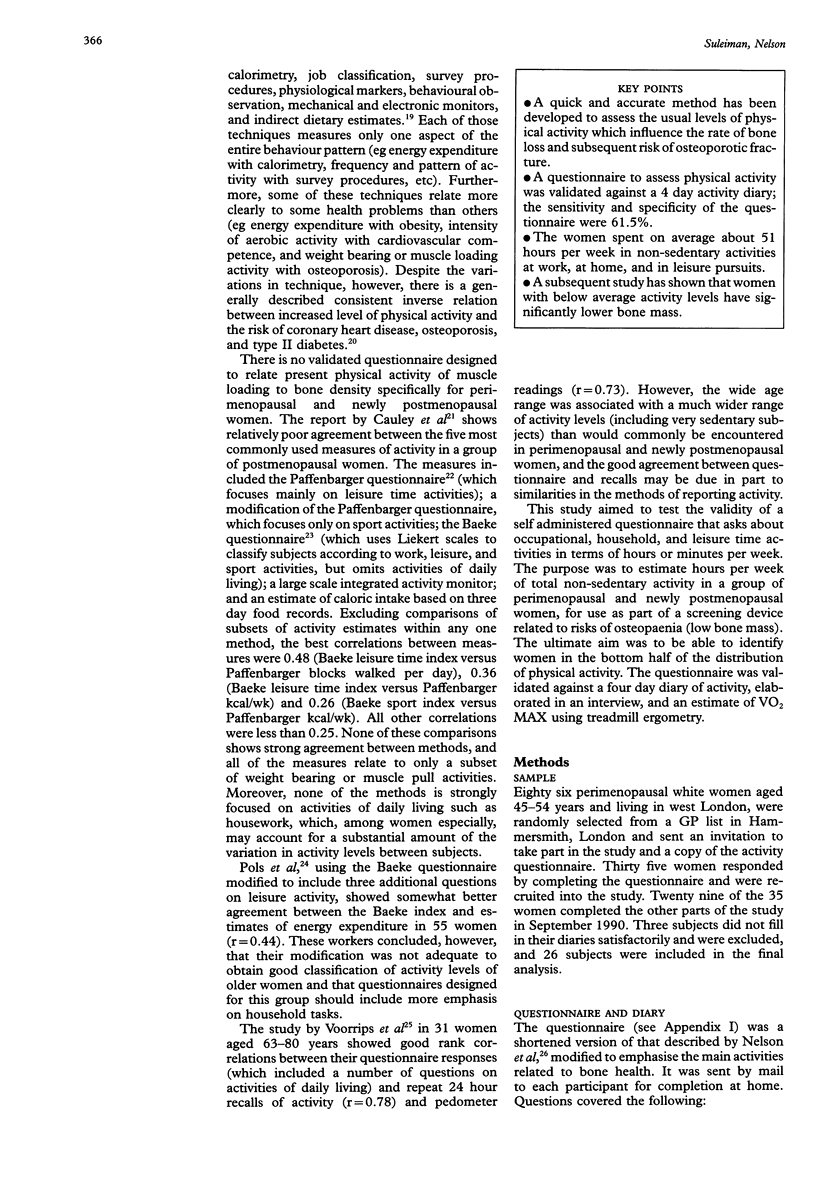
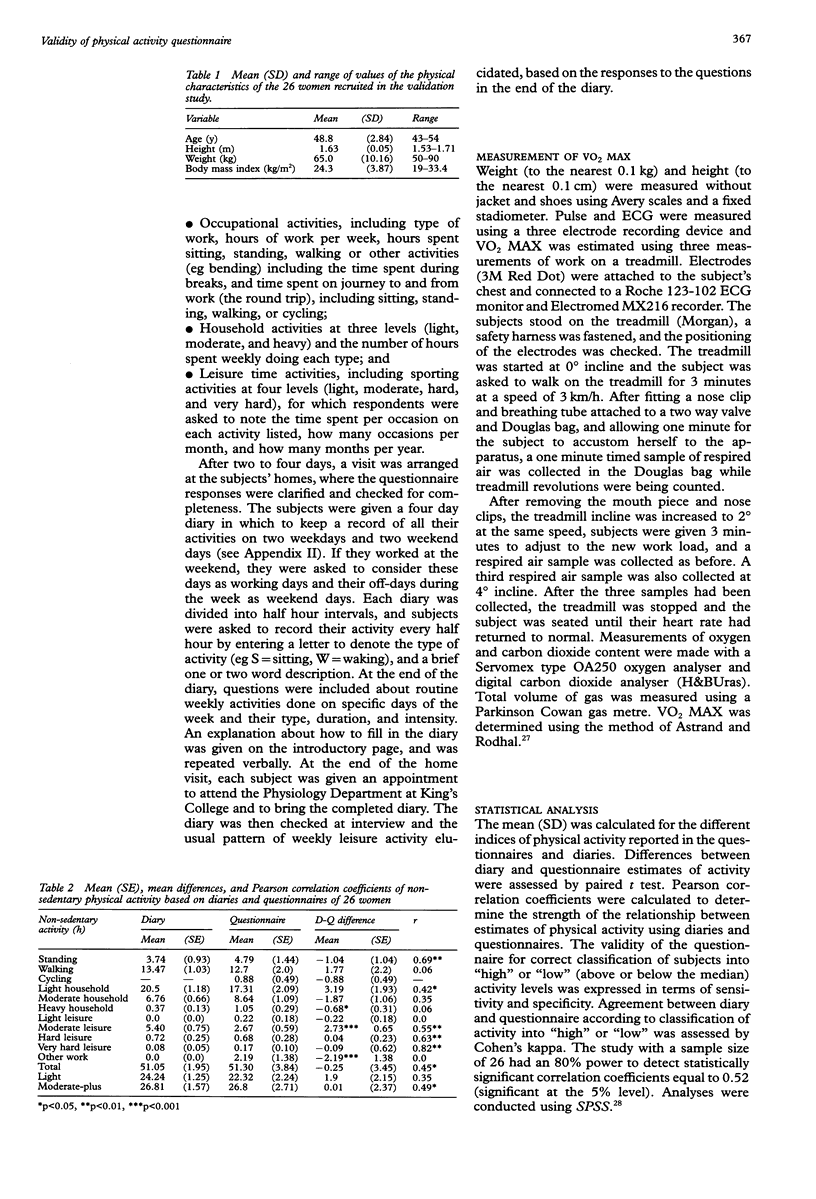
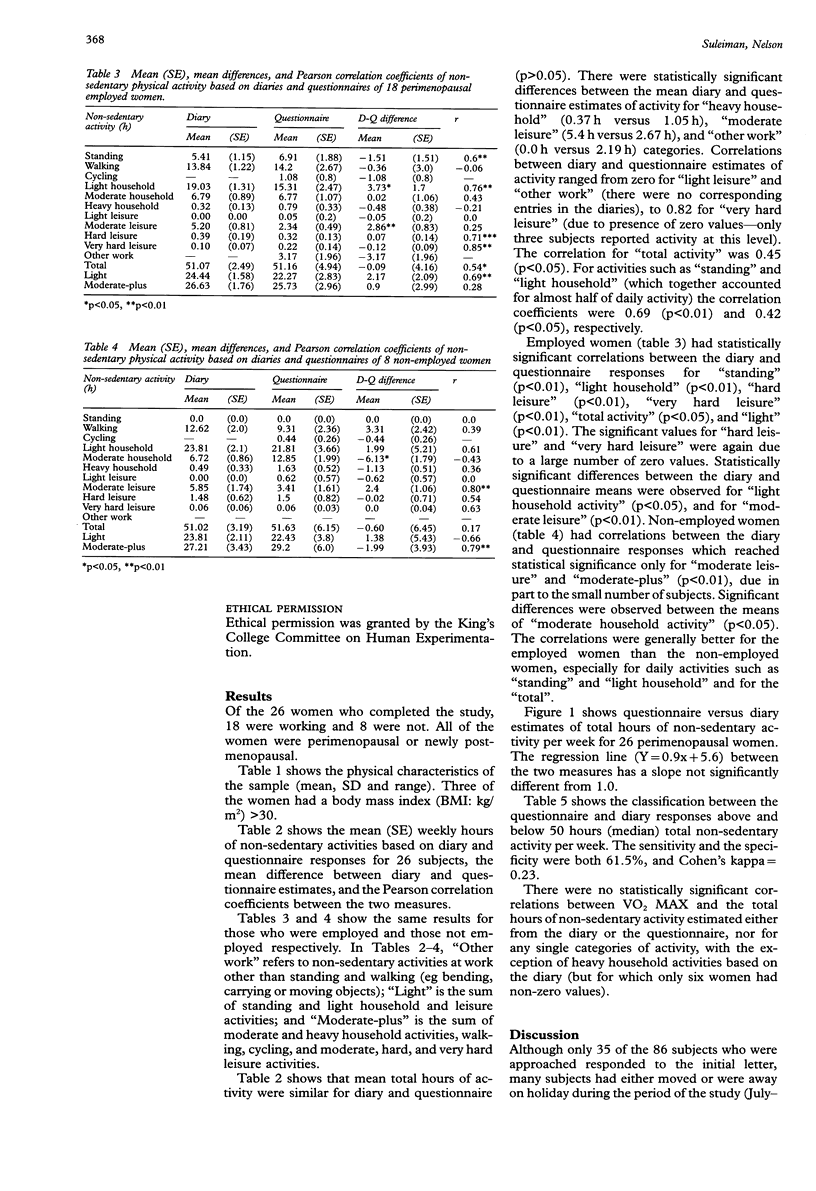
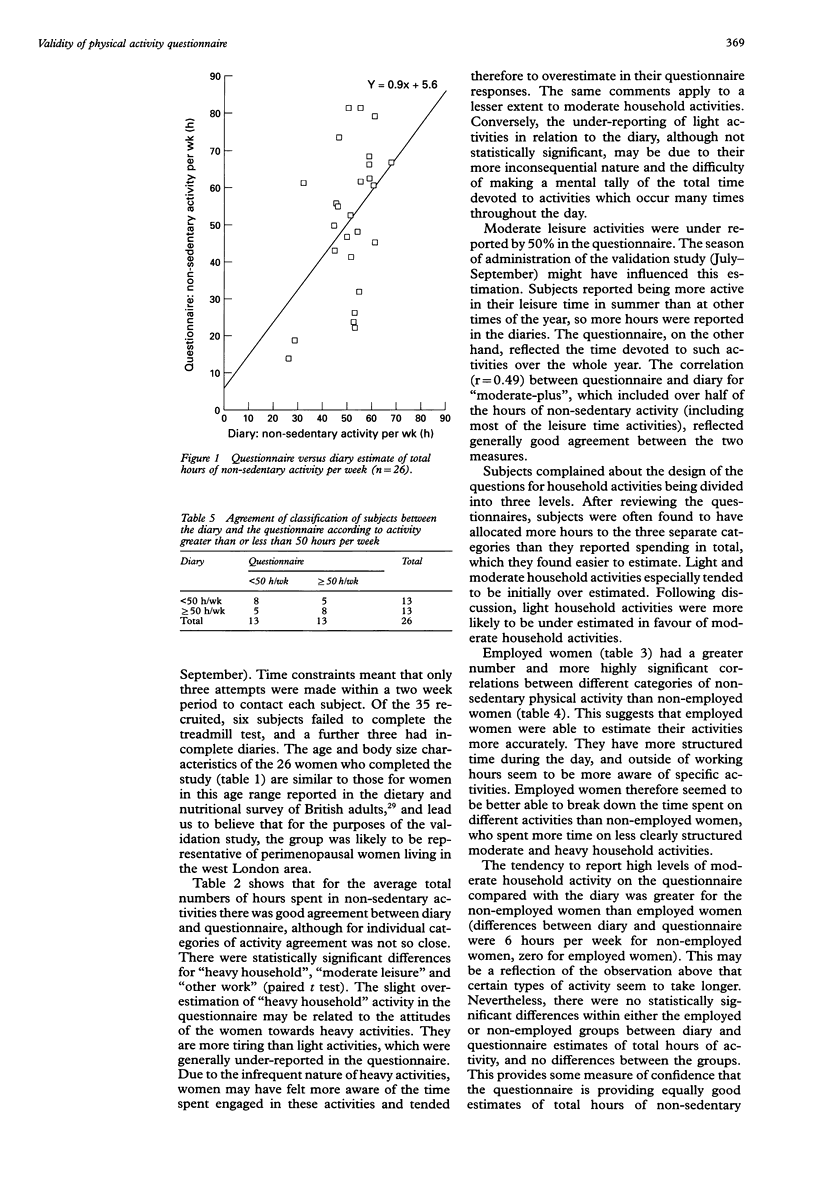
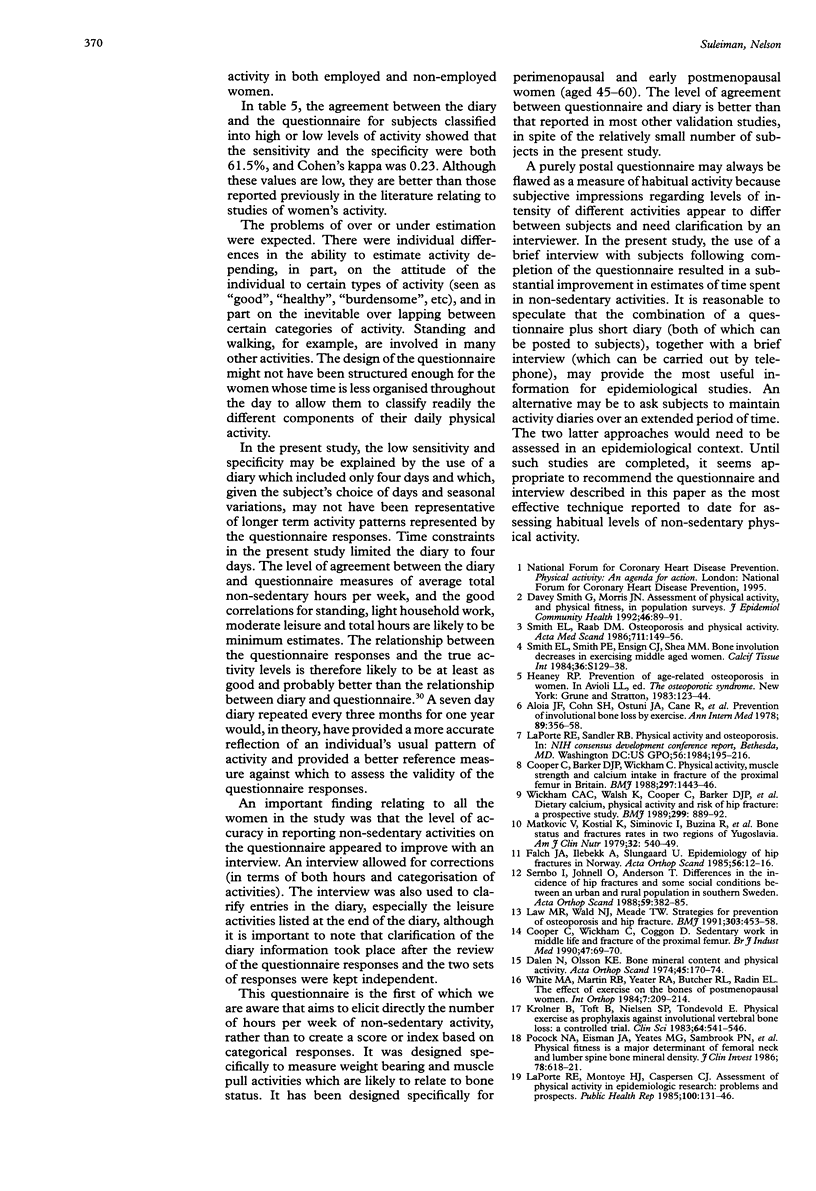
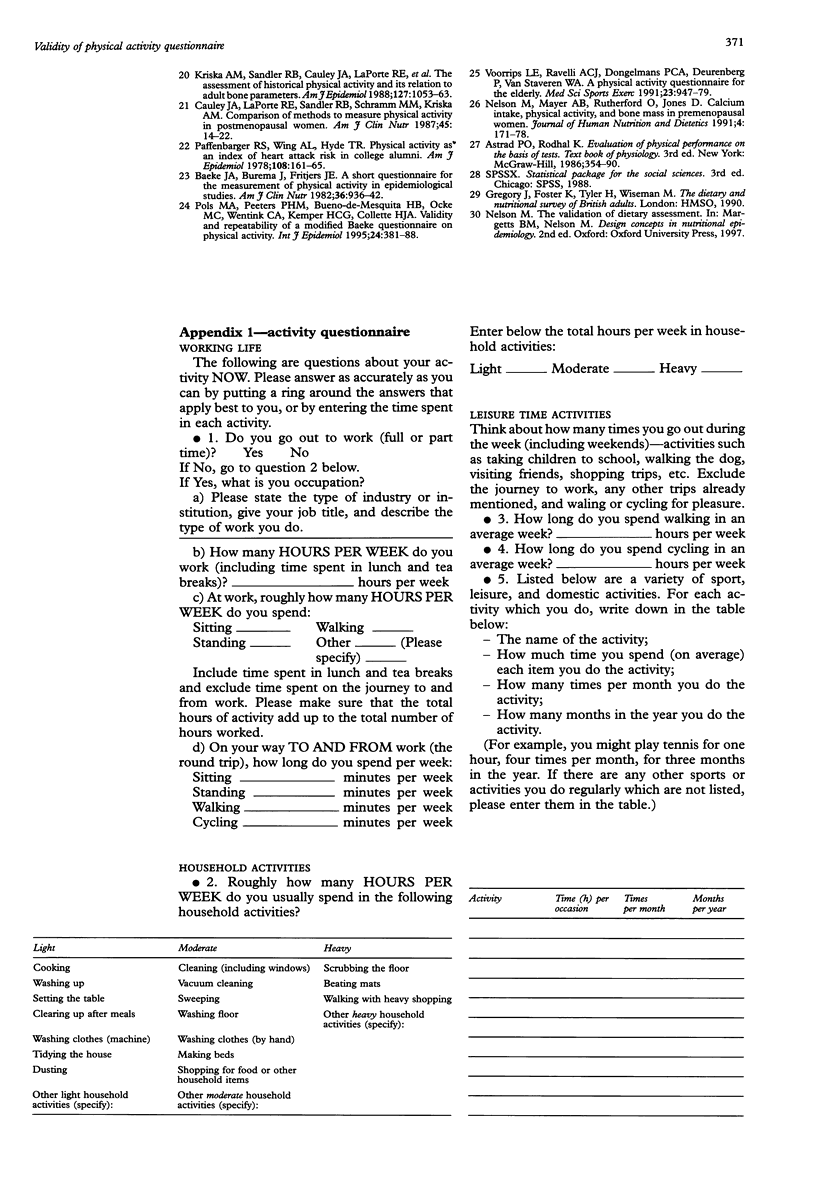
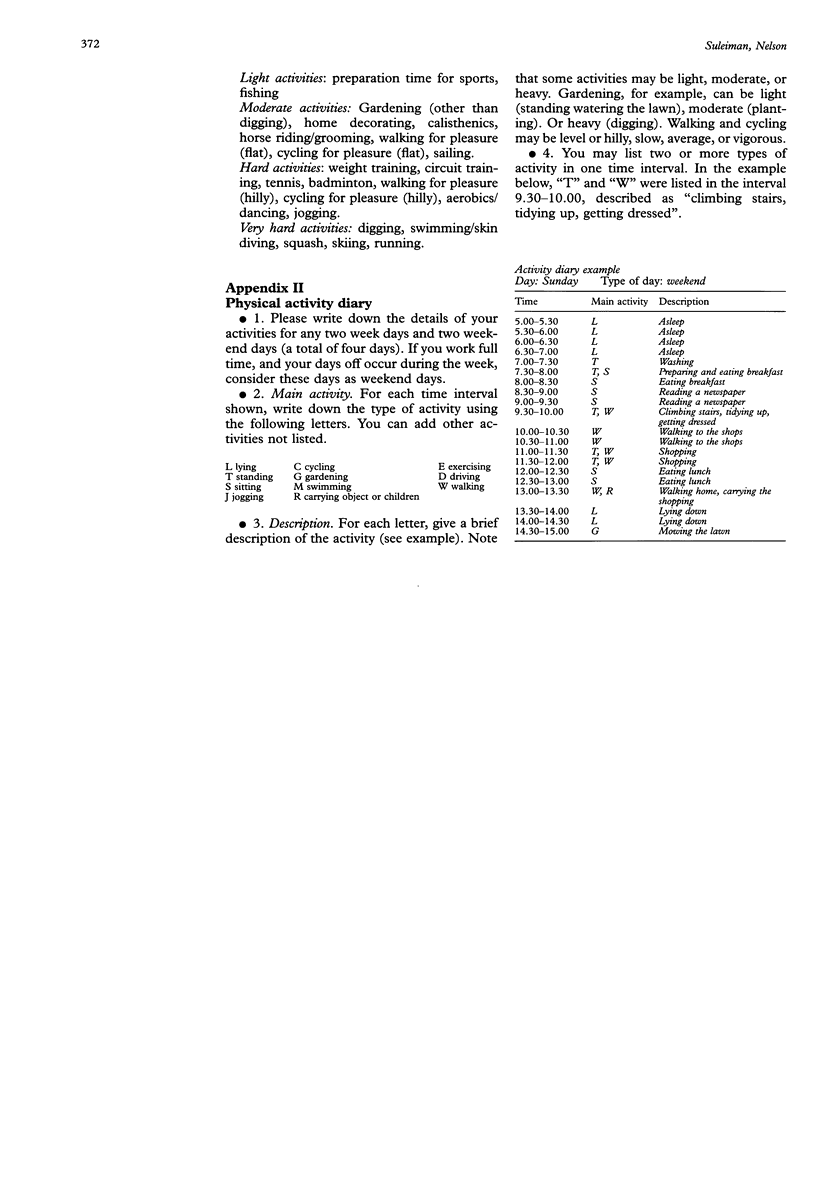
Selected References
These references are in PubMed. This may not be the complete list of references from this article.
- Aloia J. F., Cohn S. H., Ostuni J. A., Cane R., Ellis K. Prevention of involutional bone loss by exercise. Ann Intern Med. 1978 Sep;89(3):356–358. doi: 10.7326/0003-4819-89-3-356. [DOI] [PubMed] [Google Scholar]
- Baecke J. A., Burema J., Frijters J. E. A short questionnaire for the measurement of habitual physical activity in epidemiological studies. Am J Clin Nutr. 1982 Nov;36(5):936–942. doi: 10.1093/ajcn/36.5.936. [DOI] [PubMed] [Google Scholar]
- Cauley J. A., LaPorte R. E., Sandler R. B., Schramm M. M., Kriska A. M. Comparison of methods to measure physical activity in postmenopausal women. Am J Clin Nutr. 1987 Jan;45(1):14–22. doi: 10.1093/ajcn/45.1.14. [DOI] [PubMed] [Google Scholar]
- Cooper C., Barker D. J., Wickham C. Physical activity, muscle strength, and calcium intake in fracture of the proximal femur in Britain. BMJ. 1988 Dec 3;297(6661):1443–1446. doi: 10.1136/bmj.297.6661.1443. [DOI] [PMC free article] [PubMed] [Google Scholar]
- Cooper C., Wickham C., Coggon D. Sedentary work in middle life and fracture of the proximal femur. Br J Ind Med. 1990 Jan;47(1):69–70. doi: 10.1136/oem.47.1.69. [DOI] [PMC free article] [PubMed] [Google Scholar]
- Dalén N., Olsson K. E. Bone mineral content and physical activity. Acta Orthop Scand. 1974;45(2):170–174. doi: 10.3109/17453677408989136. [DOI] [PubMed] [Google Scholar]
- Falch J. A., Ilebekk A., Slungaard U. Epidemiology of hip fractures in Norway. Acta Orthop Scand. 1985 Feb;56(1):12–16. doi: 10.3109/17453678508992970. [DOI] [PubMed] [Google Scholar]
- Kriska A. M., Sandler R. B., Cauley J. A., LaPorte R. E., Hom D. L., Pambianco G. The assessment of historical physical activity and its relation to adult bone parameters. Am J Epidemiol. 1988 May;127(5):1053–1063. doi: 10.1093/oxfordjournals.aje.a114881. [DOI] [PubMed] [Google Scholar]
- Krølner B., Toft B., Pors Nielsen S., Tøndevold E. Physical exercise as prophylaxis against involutional vertebral bone loss: a controlled trial. Clin Sci (Lond) 1983 May;64(5):541–546. doi: 10.1042/cs0640541. [DOI] [PubMed] [Google Scholar]
- LaPorte R. E., Montoye H. J., Caspersen C. J. Assessment of physical activity in epidemiologic research: problems and prospects. Public Health Rep. 1985 Mar-Apr;100(2):131–146. [PMC free article] [PubMed] [Google Scholar]
- Law M. R., Wald N. J., Meade T. W. Strategies for prevention of osteoporosis and hip fracture. BMJ. 1991 Aug 24;303(6800):453–459. doi: 10.1136/bmj.303.6800.453. [DOI] [PMC free article] [PubMed] [Google Scholar]
- Matković V., Kostial K., Simonović I., Buzina R., Brodarec A., Nordin B. E. Bone status and fracture rates in two regions of Yugoslavia. Am J Clin Nutr. 1979 Mar;32(3):540–549. doi: 10.1093/ajcn/32.3.540. [DOI] [PubMed] [Google Scholar]
- Paffenbarger R. S., Jr, Wing A. L., Hyde R. T. Physical activity as an index of heart attack risk in college alumni. Am J Epidemiol. 1978 Sep;108(3):161–175. doi: 10.1093/oxfordjournals.aje.a112608. [DOI] [PubMed] [Google Scholar]
- Pocock N. A., Eisman J. A., Yeates M. G., Sambrook P. N., Eberl S. Physical fitness is a major determinant of femoral neck and lumbar spine bone mineral density. J Clin Invest. 1986 Sep;78(3):618–621. doi: 10.1172/JCI112618. [DOI] [PMC free article] [PubMed] [Google Scholar]
- Pols M. A., Peeters P. H., Bueno-De-Mesquita H. B., Ocké M. C., Wentink C. A., Kemper H. C., Collette H. J. Validity and repeatability of a modified Baecke questionnaire on physical activity. Int J Epidemiol. 1995 Apr;24(2):381–388. doi: 10.1093/ije/24.2.381. [DOI] [PubMed] [Google Scholar]
- Sernbo I., Johnell O., Andersson T. Differences in the incidence of hip fracture. Comparison of an urban and a rural population in southern Sweden. Acta Orthop Scand. 1988 Aug;59(4):382–385. doi: 10.3109/17453678809149386. [DOI] [PubMed] [Google Scholar]
- Smith E. L., Jr, Smith P. E., Ensign C. J., Shea M. M. Bone involution decrease in exercising middle-aged women. Calcif Tissue Int. 1984;36 (Suppl 1):S129–S138. doi: 10.1007/BF02406146. [DOI] [PubMed] [Google Scholar]
- Smith E. L., Raab D. M. Osteoporosis and physical activity. Acta Med Scand Suppl. 1986;711:149–156. doi: 10.1111/j.0954-6820.1986.tb08944.x. [DOI] [PubMed] [Google Scholar]
- Smith G. D., Morris J. N. Assessment of physical activity, and physical fitness, in population surveys. J Epidemiol Community Health. 1992 Apr;46(2):89–91. doi: 10.1136/jech.46.2.89. [DOI] [PMC free article] [PubMed] [Google Scholar]
- White M. K., Martin R. B., Yeater R. A., Butcher R. L., Radin E. L. The effects of exercise on the bones of postmenopausal women. Int Orthop. 1984;7(4):209–214. doi: 10.1007/BF00266829. [DOI] [PubMed] [Google Scholar]
- Wickham C. A., Walsh K., Cooper C., Barker D. J., Margetts B. M., Morris J., Bruce S. A. Dietary calcium, physical activity, and risk of hip fracture: a prospective study. BMJ. 1989 Oct 7;299(6704):889–892. doi: 10.1136/bmj.299.6704.889. [DOI] [PMC free article] [PubMed] [Google Scholar]


